For it was, in fact, after a conversation with Dr. Gachet that
van Gogh, as if nothing were the matter, went back to his room
and killed himself.
It was not because of himself, because of the disease of his own
madness, that van Gogh abandoned his life.
It was under the pressure of the evil influence, two days before
his death, of Dr. Gachet, a so-called psychiatrist, which was the
direct, effective, and sufficient cause of his death.
When I read van Gogh’s letters to his brother, I was left with
the firm and sincere conviction that Dr. Gachet, “psychiatrist,”
actually detested van Gogh, painter, and that he detested him as
a painter, but above all as a genius.
Van Gogh, the Man Suicided by Society
by Antonin Artaud (1947)

Little vase of Flowers. May-July, 1890. "In May 1890 Vincent visited his brother Theo and his family in Paris and then settled in Auvers-sur-Oise, a little village at the river Oise around 30 kilometres from Paris. The town was chosen because Paul Gachet, a doctor, artist and collector, was living there, he agreed to take care of Vincent. Vincent managed to find himself a very small room in an inn owned by Arthur Gustave Ravoux and immediately began painting the environs of Auvers-sur-Oise. "
The strange death of Vincent van Gogh. Was it a conspiracy hatched to make a fortune? When Vincent was wounded, Dr. Gachet only cleaned the wounds and let him smoke his pipe, waiting for the moment he died. He called Theo, brother of Vincent Van Gogh, and they waited until Vincent died. He did not do anything to help him. Vincent paid for his so-called medical treatment with Gachet in invaluable paintings and after the funeral the doctor took a lot of paintings with him. He was an art-connoisseur and knew, as one of the few in the world, that he added masterworks to his collection, and that for free!
Probably one day the mortal remains of Vincent van Gogh will be exhumed. A DNA-test should be possible and we shall know more about his diseases and, too, there still has to be the bullet that remained in the body and the bullet could tell us a lot…
“We are all Pilgrims at the Edge. At the edge of our perception….co-creators with the Almighty…we paint on the canvas of life….some paint in colors,some in black and white…some add music and prayer and light.
Paint my world with your love.
peace.” ( Pat Colluci )
…Tom Hirschig was dispatched to fetch Dr. Mazery, the local practitioner, but couldn’t find him, so Ravoux sent him to get Dr Gachet. Gachet dressed Vincent’s wound, but Adeline Ravoux swears he declared the patient beyond hope and abruptly left. Emile Bernard, though, believes Gachet thought he could save him, but Vincent merely replied, “Then it has to be done over again.” The bullet in Vincent’s chest was not removed. Ravoux and Hirschig remained at Vincent’s side, repeatedly filling and lighting his pipe for him. He often moaned in pain but also slept on and off.
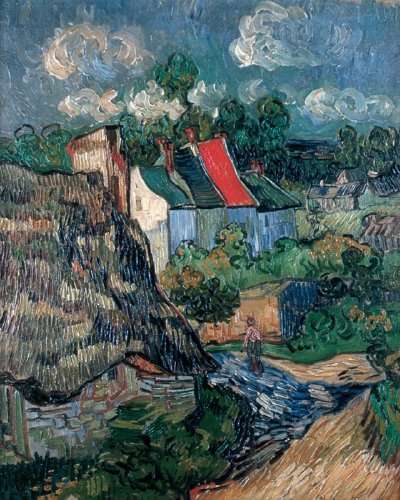
"Houses at Auvers was painted in 1890, shortly after Vincent van Gogh arrived in Auvers-sur-Oise and he seemed to be on the mend. Indeed, Vincent's first letters to his brother Theo from Auvers-sur-Oise were cautiously optimistic. His health was good, and he found his room comfortable. The village had a picturesque appeal; even the new homes were "radiant and sunny and covered with flowers." Unlike the writhing rhythms that characterized his landscape work at Saint-Rémy, Vincent van Gogh's first paintings at Auvers, such as Houses at Auvers, exhibited a new stability, seen in
strongly interlocked strokes of heavy pigment."Tuesday, July 29, 1890
Soon after the sun was up on Monday morning two gendarmes appeared at the inn and asked Vincent if he was the one “who wanted to commit suicide”. “Yes, I believe.” “You know that you do not have the right?” “My body is mine,” Vincent replied calmly, “and I am free to do what I want with it. Do not accuse anybody — it is I who wished to commit suicide.”
Ravoux had determined that Theo van Gogh worked for the Art Gallery of Boussod Valadon on Boulevard Montmartre in Paris and sent a telegram. Theo arrived by train by mid-afternoon and ran from the station to the inn. He immediately joined his brother and remained at his side. “I found him somewhat better than I expected,” Theo wrote to his wife. The siblings spoke at some length, Theo urging him on but being spurned with the words, “The sadness will last forever.” Then Vincent lapsed into a coma. They said the last words he uttered were, “I wish I could pass away like this.”

"Daubigny's Garden by Vincent van Gogh Vincent van Gogh painted Daubigny's Garden in 1890 in honor of Charles-François Daubigny, who was an early practitioner of plein air painting. Daubigny settled in Auvers-sur-Oise and lived there until his death nearly two decades before Vincent van Gogh's arrival. Daubigny's widow still lived in the house when Vincent painted Daubigny's Garden in delicate tones of pink, green, and violet. Vincent van Gogh's great fidelity to natural tones pays tribute to Daubigny's own adherence to nature. "
He died at 1.30 this morning.
Ravoux signed a formal declaration of death at the town hall.
The priest at Notre Dame d’Auvers refused to say mass for a suicide. The windows of the hotel were shuttered and, in the afternoon, Vincent’s body was bought downstairs to the lobby, which had been adorned with flowers by Hirschig, mostly cheerful sunflowers.
Théo ringed the room with Vincent’s paintings, among them “The Church of Auvers”, “Irises”, “The Garden of Daubigny” and “Child with an Orange”, the last one a portrait of the two-year-old son of the village carpenter, Levert, who had built the coffin and provided the supports on which it rested. At its foot were Vincent’s palette and brushes. He still had plenty of material from Theo to continue painting and he’d talked of new ideas he wanted to try.
… Dr. Gachet did a deathbed charcoal drawing of Vincent, signed with his pseudonym, Van Ryssel. Vincent’s body was placed in a coffin that had been lifted onto the Ravoux billiard table, and he was buried on July 30 in a corner of the Auvers cemetery. Dr. Gachet spoke, but his words were drowned in his own sobs. After the funeral, according to Adeline Ravoux, “M.Theo asked Dr. Gachet to take the remaining paintings. He didn’t have to be asked twice, and with his son’s help he rolled up canvas after canvas.
Dr. Gachet had written Theo that Vincent had asked for him, which was untrue. He had been called, because the first doctor, Mazery, was not at home. In any case, he did nothing to save Vincent. Although Gachet styled himself as a specialist in nervous diseases, nothing in his behavior suggests that he understood that a bungled suicide is a cry for help. He left Vincent to die in his garret room, grossly underestimating the gravity of his wound and not bothering to have him hospitalized, an act of negligence that would at best be called malpractice. And, once Vincent was dead, he threw himself into the role of grieved friend and gathered up Vincent’s canvases with greedy dispatch. All in all, Dr. Gachet leaves a distasteful impression.
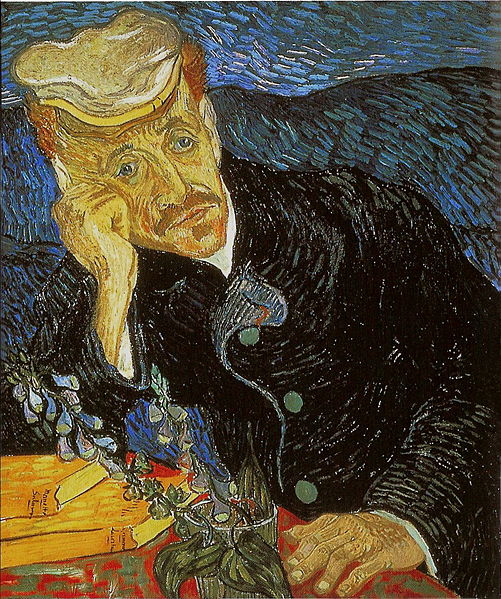
"If you were really paying attention, you might have noticed Dr. Gachet hanging out in other famous museums, looking entirely different. Dr. Paul Ferdinand Gachet was no ordinary artists’ model. Nor was he an ordinary doctor. His specialty was melancholy, professionally and personally. Van Gogh was under his care during the last 80 days of his life (and proclaimed the doctor “sicker than I am” in a letter to Theo). Gachet was friends with and treated Pissarro, Renoir, Manet and Cezanne just to name a few. He had amassed one of the largest impressionist art collections in Europe before he died in 1909. Oddly, the information out there on him is pretty sketchy."
We should not, however, accept Artaud’s view of Gachet as ” the direct, efficient, and sufficient cause” of Van Gogh’s death. For it seems clear that we are dealing here with two unbalanced men. One was the patient, while the other, unfortunately, was the doctor. When Vincent became angry over the unframed Guillaumin, Dr. Gachet abandoned his patient. A mercurial, often thoughtless person, perhaps Gachet did not realize how grave it is for a doctor, who embodies the promise of health to ignore the person he is supposed to be helping.
If Gachet did realize dependent Vincent was on him, then his neglect of his patient was criminal; in the moral if not the legal sense. In any case, it is a fact that at the very moment that Vincent was taking upon himself all of Theo’s problems , Dr. gachet was divesting himself of the problem Vincent represented in his life. The problem may have been more than that between patient and doctor, if we are to believe one of the foremost Van Gogh experts, Marc-Edo Tralbaut, who has devoted his life to the study of the painter and who personally knew Dr. Gachet’s son and daughter.
Tralbaut suggests that Vincent had formed an attachment to Dr. Gachet’s daughterand was told by the doctor that he must stop seeing Marguerite. When Vincent abruptly brought up the topic of marriage in his letter to Theo, he was thinking of Marguerite and his last chance to found a family; only to be rebuffed by her father, a man he considered his friend and helper. Tralbaut claimed he believed Marguerite Gachet had returned Vincent’s feelings. He said he had been told by a girlhood friend of Marguuerite’s “that she had fallen in love with Van Gogh”, which is difficult to verify. What is known, is that Marguerite Gachet suffered a serious depression after Vincent’s death , that she never married, and that she lived as a recluse in Auvers, where even her own neighbors seldom saw her.

"Van Gogh scholar, Dr. Jan Hulsker, author of The New Complete Van Gogh: Paintings, Drawings, Sketches comments . . . . . . For the question of Van Gogh shown clean-shaven on the drawing on his death-bed I can tell you only this. It seems impossible to find out in the documents if Vincent had a beard when he was in Auvers, or not. Don't be mistaken about the so-called "last" self-portrait: JH 1780, F 528. It probably is a fake,..."
And we do know, that when Dr. Gachet came to Vincent’s side on July 27, he was no longer a friend. The two men, according to Adeline Ravoux, did not exchange a single word. Whatever there was between them, whether it was Marguerite or simply an accumulation on mutual ill-will between two unstable men died with Vincent. Dr. Gachet would not discuss it.
Vincent left Theo three things: his Auvers paintings and drawings, many of which Theo gave to Dr. Gachet; an un-mailed letter found on his person, in which Vincent said, ” I tell you again that I shall always consider you to be something more than a simple dealer in Corot’s , that through my mediation you have your part in the actual production of some canvases, which will retain their calm even in the catastrophe… Well, my own work, I am risking my life for it and my reason was half foundered because of it.”

"Vincent met with Dr. Gachet shortly after his arrival in Auvers. Although initially impressed by Gachet, Vincent would later express grave doubts about his competence, going so far as to comment that Gachet appeared to be "sicker than I am, I think, or shall we say just as much". Only three weeks after his arrival, Van Gogh would write that he and Paul Gachet had become “great friends.”
For without Vincent as a mediator, Theo’s mind snapped. It was as if the true nature of their pact had been that Theo assumed the financial burdens for both brothers while Vincent dealt with their demons. So interwoven were their lives that it was not only his own mental balance that Vincent was struggling to keep, it was Theo’s.
Theo remained on excellent terms with Dr. Gachet. They exchanged several friendly letters. It never even crossed Theo’s mind that Dr. gachet was in any way responsible for his brother’s death. In fact, Theo and Johanna still considered Gachet the Van Gogh family doctor.
On October 10, 1890, almost two and a half months after Vincent’s death, Dr. Gachet received a letter from Joanna van Gogh’s brother expressing the situation in which Theo was quarreling with his employer and wanted to set himself up independently without delay. “The memory of his brother haunts him to such a point that he quarrels with all those who disagree with him.” Two days later, with Dr. Gachet’s consent, Theo was committed to a private asylum. He improved and was allowed to go to Holland and see his family. But the illness had attacked his body as well as his mind, and he died in Utrecht of general paralysis on January 25, 1891, at the age of thirty three. He was buried there, but his body was later exhumed and reburied in Auvers beside his brother’s. Their remains lie under identical tombstones, as close as their psyches had been in life.
Dr. Gachet continued practicing and exhibiting his canvases, signed Van Ryssel, at the Salon des Independants in paris. He took part in a signboard contest, submitting a picture of a pig for a charcuterie. He died in 1909 at the age of eighty.
Whether Artaud’s assertions that doctor’s are the natural enemy of artists is true; remains a point of divisive contention. The conflicting and sometimes allied forces of madness and artistic expression remain misunderstood to our day. Artaud claimed that artists were subversives who challenged a society’s established values, while the doctors who treated them were the guardians of those values, their unavoved mission to destroy the artist.
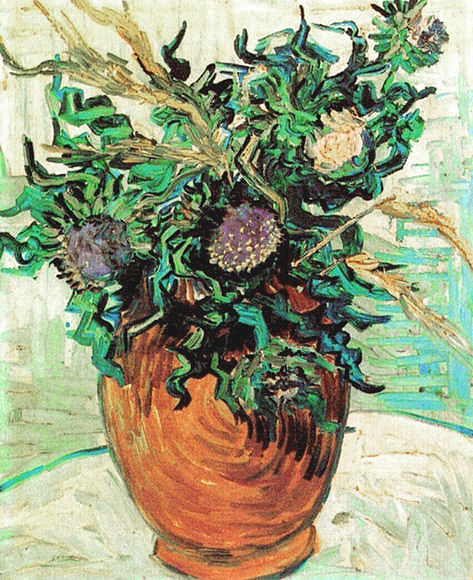
Vase with Thistles..." one of the several still lifes that Van Gogh painted on either June 16 or 17, 1890, depicting some wild flowers that he had found at Gachet's house. The only surviving still lifes by Van Gogh of wild flowers that include thistles are this work and Wild Flowers and Thistles in a Vase in a private collection. While different flowers are featured in the two paintings, they have been arranged in the same vase on a round table in both cases. The two works are therefore thought to have been painted around the same time. In the outlines that define the table and the vase, one can perceive the influence of the ukiyo-e prints Van Gogh collected so enthusiastically in Paris."
“David Carmichael, a mentally-ill youth fitness advocate and aspiring federal politician who drugged and suffocated his 11-year-old son in a hotel room, is not your typical academic conference presenter. Then again, PsychOUT, a controversial strategy session this weekend at the University of Toronto for “organizing resistance against psychiatry,” is not a typical conference.
A rare global event for the anti-psychiatry movement, with speakers from as far as Ghana, it is billed as a celebration of Mad Pride with an eye to the future overthrow of psychiatry, which has replaced religion as the primary oppressor of the human mind. As organizer Bonnie Burstow puts it, modern psychiatry is beyond saving, and destroying it “is unachievable in the short run. But the long run is a very different thing.” As a first step, the conference will promote new Ontario legislation aimed at defunding electroshock therapy, seen by anti-psychiatrists as a particularly brutal assault on people unfairly labelled as crazy.
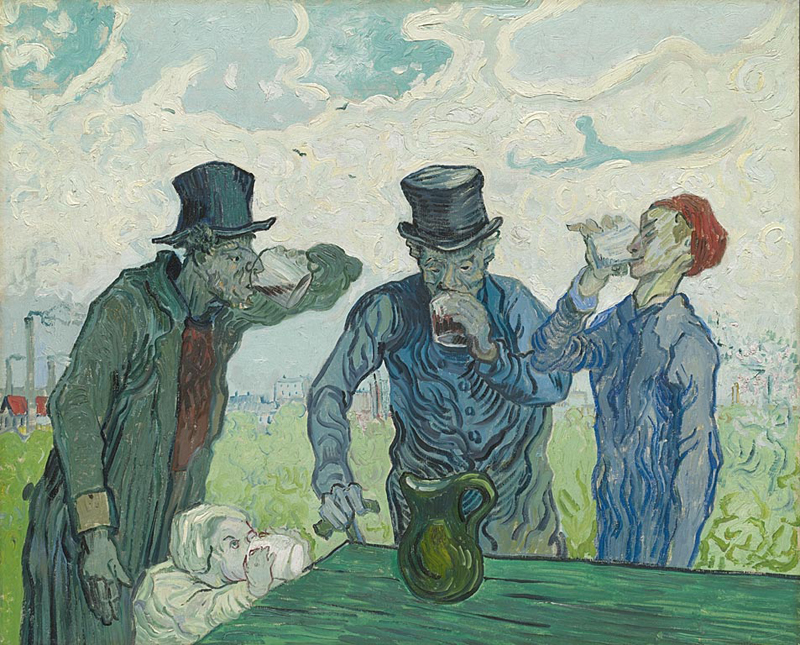
"The Drinkers", oil on canvas, 59.4 x 73.4 cm, 1890. The Art Institute, Chicago, USA. Vincent drank too much alcohol: "... the only thing to bring ease and distraction, in my case and other people's too, is to stun oneself with a lot of drinking or heavy smoking. (Letter from Vincent van Gogh to Theo van Gogh, June 29, 1888)
Gachet owned a great collection of paintings. He always tried to get art for a low price or even nothing. E.g. in 1878 Monet painted his “Chrysanthemums,” and gave it to Dr. Gachet after a squabble about its price, the same year 1878 Renoir painted his “Portrait of a Model” and gave it to Dr. Gachet for his visit to the young model who was dying of smallpox.
He never paid Vincent van Gogh for his now invaluable paintings.
After the physician’s visit, Father told us: “Dr. Gachet has examined Mr. Vincent and has dressed his wound with bandages that he had himself brought “(someone had warned him that it concerned a casualty). He judged the case hopeless and left immediately. I am absolutely certain that he did not return: neither that evening, nor the following day. Father told us again: “During the examination and when he was bandaging the wound, Dr. Gachet did not say a word to M. Vincent.”


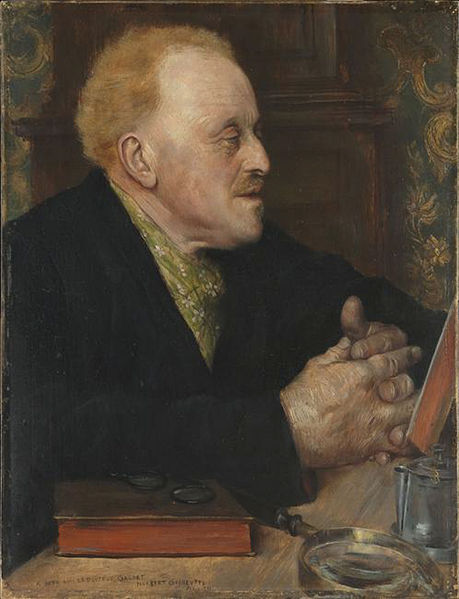
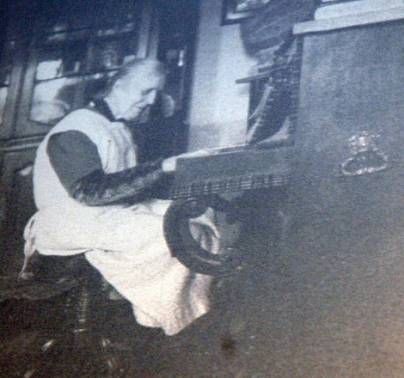
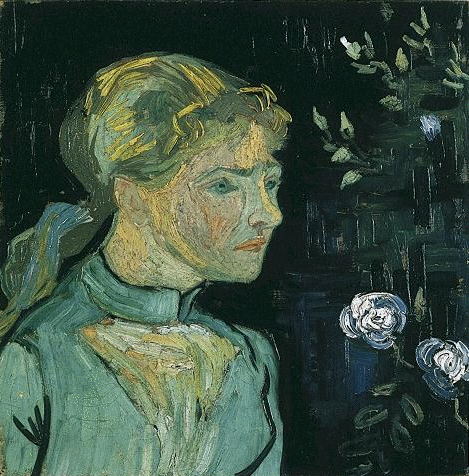



 COMMENTS
COMMENTS